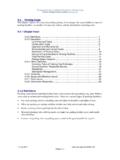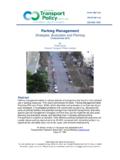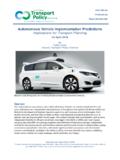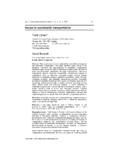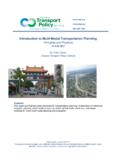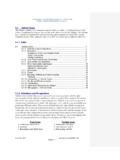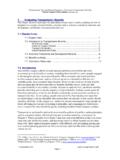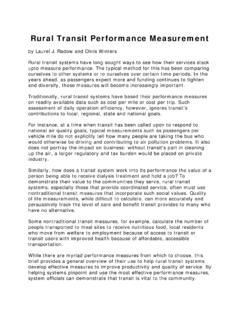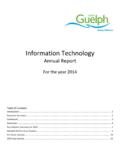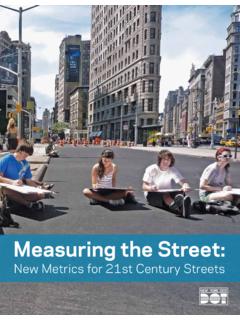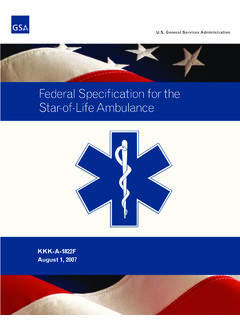Transcription of Measuring Transportation - vtpi.org
1 250-360-1560 Todd Alexander Litman 2003-2011 You are welcome and encouraged to copy, distribute, share and excerpt this document and its ideas, provided the author is given attribution. Please send your corrections, comments and suggestions for improvement. Measuring Transportation Traffic, Mobility and Accessibility 1 March 2011 By Todd Litman Victoria Transport Policy Institute The ultimate goal of most Transportation is access, people s ability to reach desired goods, services and activities. Transportation decisions often involve tradeoffs between different forms of access. How transport is measured can have a major impact on these tradeoffs.
2 Abstract This article compares three approaches to Measuring Transportation system performance and discusses their effects on planning decisions. Traffic-based measurements (such as vehicle trips, traffic speed and roadway level of service) evaluate motor vehicle movement. Mobility-based measurements (such as person-miles, door-to-door traffic times and ton-miles) evaluate person and freight movement. Accessibility-based measurements (such as person-trips and generalized travel costs) evaluate the ability of people and businesses to reach desired goods, services and activities. Accessibility is the ultimate goal of most Transportation and so is the best approach to use.
3 Originally published in ITE Journal (Institute of Transportation Engineers, ) Vol. 73, No. 10, October 2003, pp. 28-32, Measuring Transportation Victoria Transport Policy Institute 2 Introduction Management experts often say that, you can t manage what you can t measure. What is measured, how it is measured, and how data are presented can affect how problems are evaluated and solutions selected. For example, a baseball player s performance can be evaluated based on batting averages, base hits, runs batted in, and ratio of wins to losses, plus various defense statistics that depend on the player s position. Performance statistics can be calculated per at-bat, per inning, per game, per season, or for a career.
4 A player can be considered outstanding according to one set of statistics but inferior according to another. This is just one example of how different measurement methods can give very different impressions about a person, group or activity. Often, there is no single method or unit that conveys all the information needed for evaluation. Different measurement units represent different perspectives and assumptions. A coach needs to consider several different statistics when evaluating how a particular player fits into a team. It is important that decision-makers understand the different perspectives and assumptions implicit in the measurement units they use.
5 This article discusses three common methods used to measure Transportation , the perspectives they represent, and how the selection of one or another method can affect planning decisions. Accuracy Versus Precision Statisticians make a distinction between accuracy and precision. Accurate means truthful or correct. Precise means measured using small units. Data can be very precise, but inaccurate. For example, doctors often measure their patients weight to help evaluate their health. But weight by itself is an inadequate indicator of health. It would be inaccurate to say that everybody who weighs less than 175 pounds is healthy and everybody who weighs more than 175 pounds is unhealthy.
6 People with different heights and builds have different optimal weights, so medical professionals must use weight-height tables or body-mass indices to interpret the health implications of a particular person s weight. A standard medical scale can measure a person s weight within about pound of accuracy. A more expensive scale can provide greater precision, but there is little point in purchasing a super-precise scale simply to track body weight. Knowing that you weigh exactly pounds rather than about 170 pounds does little to improve your health assessment. Weight is relatively easy to measure and understand, but focusing too much attention on weight may distract doctors and patients from considering other health factors that are equally important but more difficult to measure, such as whether you eat a balanced diet or get sufficient exercise.
7 Similarly, vehicle traffic volumes and speeds are relatively easy to measure and so are often used to evaluate transport system quality. But other more difficult factors may be equally important, such as walking conditions, the distribution of common destinations, and the ease with which non-drivers can perform activities such as commuting and shopping. An accurate assess of transport system quality requires that these factors be considered even if their measurement is less precise than those Measuring traffic. Measuring Transportation Victoria Transport Policy Institute 3 Evaluation Perspectives Transportation systems can be evaluated in various ways that reflect different perspectives concerning users, modes, land use, transport problems and solutions, how transport activity is measured, and the type of performance indicators Three perspectives, called traffic, mobility and accessibility, are compared below.
8 Traffic Definition Traffic refers to vehicle movement. This perspective assumes that travel means vehicle travel and trip means vehicle-trip. It assumes that the primary way to improve Transportation system quality is to increased vehicle mileage and speed. Users From this perspective, Transportation users are primarily motorists (including drivers and passengers). Non-motorists are considered a relatively small and unimportant minority, defined as members of households that do not own an automobile. Modes This perspective focuses on automobile travel. It places little value on transit and cycling, since they represent a small portion of vehicle-mileage and are relatively slow.
9 It considers walking primarily as a way for motorist to access parking facilities or as a form of recreation, and so devotes little Transportation funds to nonmotorized facilities. Figure 1 Traffic Traffic refers to vehicle movement. A traffic perspective measures vehicle traffic speeds and volumes, using Level of Service ratings and average traffic speeds as indicators. This tends to favor high-speed, high-volume roadways, resulting in more automobile-dependent Transportation systems and land use patterns. Land Use This perspective evaluates land use primarily in terms of proximity to highways and parking supply.
10 The best location for a public facility is along a major arterial or freeway intersection. Downtown locations are undesirable due to excessive roadway congestion and parking costs. Transport Problems and Solutions This perspective defines Transportation problems in terms of costs, barriers and risks to motorists. It favors solutions that increase road and parking capacity, roadway traffic speeds, vehicle ownership, and the affordability of driving. From this perspective, the best way to benefit non-drivers is to help them become motorists, by making automobile and taxi travel convenient and inexpensive. Measuring Transportation Victoria Transport Policy Institute 4 Measurement Vehicle traffic is relatively easy to measure.

